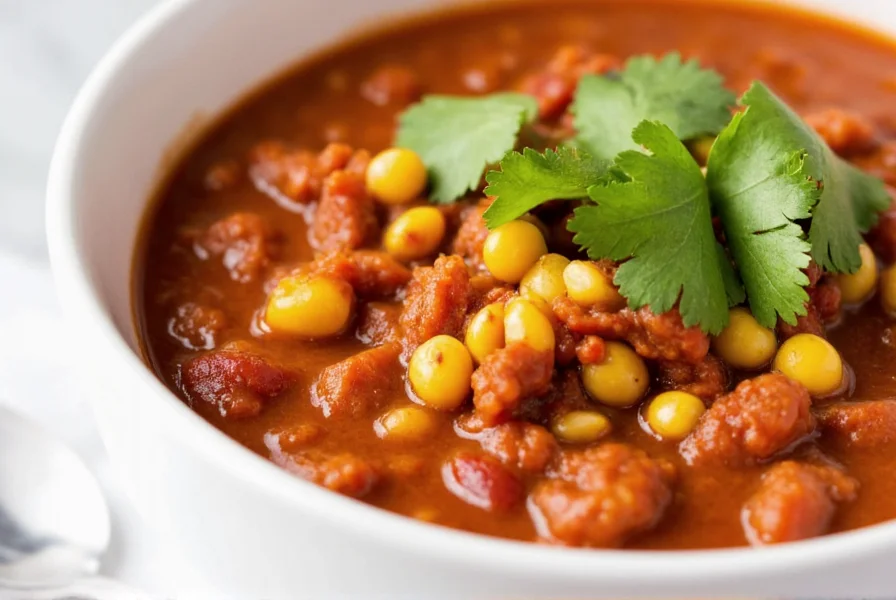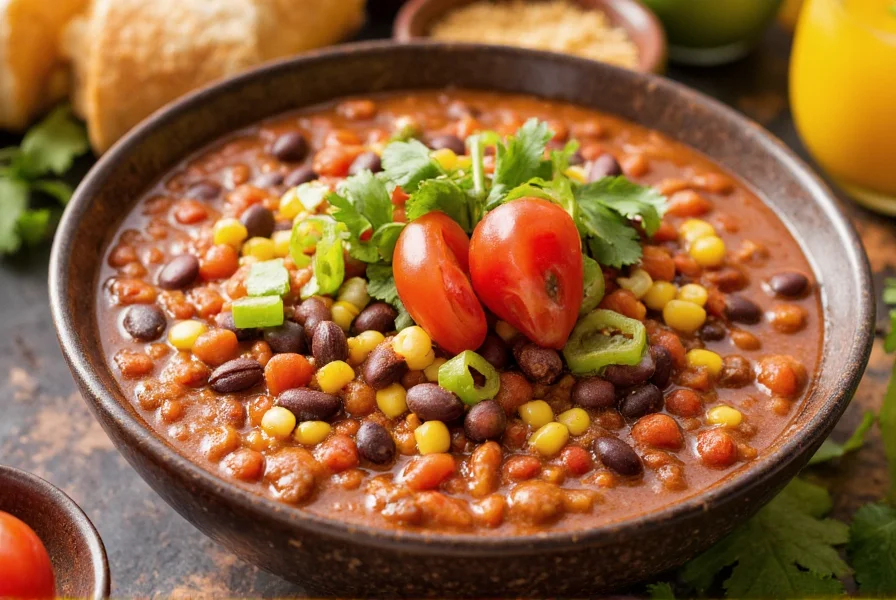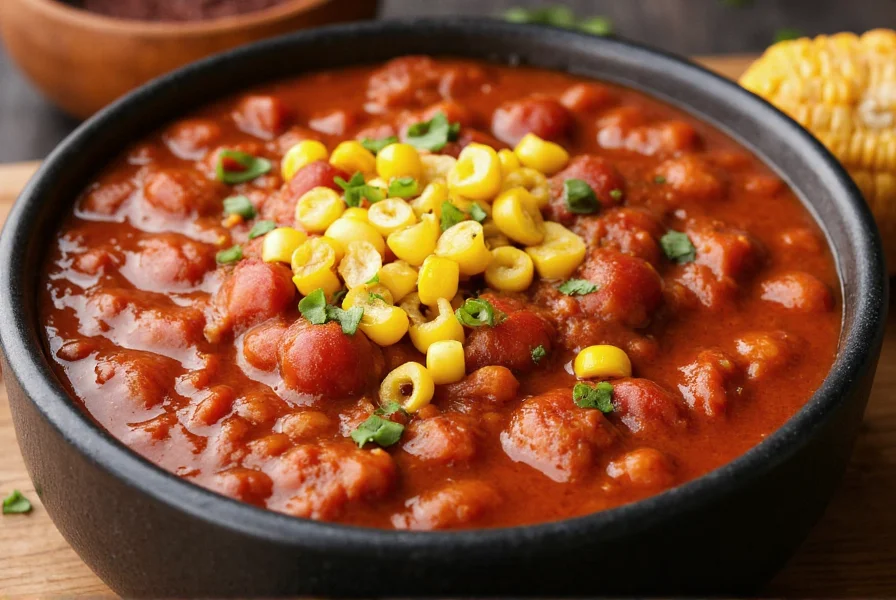Adding corn to chili creates a delightful textural contrast that elevates this classic comfort food. The sweet crunch of corn kernels balances the deep, smoky flavors of traditional chili ingredients like tomatoes, beans, and spices. This combination isn't just delicious—it's rooted in culinary tradition. Corn has been a staple in Southwestern cooking for centuries, making its inclusion in chili both historically authentic and flavorfully brilliant.
Why Corn Belongs in Your Chili
Corn isn't just a random addition to chili—it serves multiple culinary purposes. The natural sugars in corn create a subtle sweetness that counteracts the heat from chili peppers without masking their complex flavors. This balance makes chili more approachable for those who prefer milder dishes while still satisfying spice enthusiasts.
From a textural perspective, corn provides intermittent bursts of crunch that contrast beautifully with the soft beans and tender meat in traditional chili. This textural variety keeps each bite interesting and prevents the dish from becoming monotonous. Nutritionally, corn contributes valuable fiber, vitamins, and minerals that complement the protein-rich base of chili.
| Corn Type | Best For | When to Add | Flavor Impact |
|---|---|---|---|
| Fresh corn kernels | Summer chili, peak flavor | Last 10 minutes of cooking | Bright, sweet, vegetal notes |
| Canned corn | Year-round convenience | Last 5 minutes of cooking | Mellow sweetness, consistent texture |
| Frozen corn | Off-season cooking | Last 7 minutes of cooking | Clean corn flavor, good texture |
| Roasted corn | Smoky flavor profiles | As finishing garnish | Deep, caramelized sweetness |
Traditional Preparation Techniques
When incorporating corn into chili, timing matters significantly. Adding corn too early causes it to break down and lose its distinctive texture, while adding it too late means it doesn't absorb the surrounding flavors. For optimal results, add corn during the final 5-10 minutes of cooking—just enough time for it to warm through and absorb some surrounding flavors without becoming mushy.
Many experienced chili makers recommend reserving a small portion of corn to add as a fresh garnish just before serving. This technique creates a delightful contrast between the cooked corn in the chili and the crisp, raw kernels on top. For an extra flavor dimension, consider roasting fresh corn before cutting it from the cob—this caramelizes the natural sugars and adds a subtle smokiness that complements traditional chili spices.
Perfect Chili with Corn Recipe
This authentic Southwest-style chili with corn balances traditional elements with the sweet crunch of corn. The recipe serves 6-8 and takes approximately 1 hour 15 minutes from start to finish.

Ingredients
- 2 tablespoons olive oil
- 1.5 lbs ground beef or plant-based alternative
- 1 large yellow onion, diced
- 4 cloves garlic, minced
- 2 bell peppers (any color), diced
- 2 (15oz) cans kidney beans, drained and rinsed
- 1 (28oz) can crushed tomatoes
- 1 (15oz) can tomato sauce
- 1 cup corn kernels (fresh, frozen, or canned)
- 2 tablespoons chili powder
- 1 tablespoon cumin
- 1 teaspoon smoked paprika
- 1/2 teaspoon cayenne pepper (adjust to taste)
- Salt and black pepper to taste
Step-by-Step Instructions
- Heat olive oil in a large pot over medium-high heat. Brown the ground beef, breaking it into small pieces, until no pink remains. Drain excess fat if desired.
- Add onions, garlic, and bell peppers. Cook until vegetables soften, about 5-7 minutes.
- Stir in chili powder, cumin, smoked paprika, and cayenne. Cook for 1 minute to toast the spices.
- Add crushed tomatoes, tomato sauce, and kidney beans. Bring to a simmer.
- Reduce heat to low, cover, and simmer for 45-60 minutes, stirring occasionally.
- Add corn during the last 10 minutes of cooking. Reserve 2 tablespoons of corn for garnish if desired.
- Season with salt and black pepper to taste. For best flavor, let chili rest for 15 minutes before serving.
Variations for Different Dietary Preferences
Chili with corn adapts beautifully to various dietary needs while maintaining its essential character. For vegetarian chili with corn, simply substitute the ground beef with additional beans, lentils, or a quality plant-based meat alternative. The corn's natural sweetness complements earthy vegetarian ingredients particularly well.
For those seeking a low-carb version of chili with corn, consider reducing the corn quantity by half and adding extra bell peppers for similar texture without the carbohydrates. Gluten-free diets present no challenge, as traditional chili with corn is naturally gluten-free when using appropriate spice blends.

Serving Suggestions That Elevate Your Chili
The right accompaniments can transform your chili with corn from a simple meal to a memorable dining experience. Traditional toppings include shredded cheddar cheese, sour cream, and fresh cilantro, but consider these professional chef recommendations for added dimension:
- Lime wedges: A squeeze of fresh lime juice brightens the entire dish
- Avocado slices: Adds creamy texture that contrasts with the corn's crunch
- Green onions: Provides mild onion flavor without overpowering
- Crumbled tortilla chips: Creates additional textural contrast
For complete meal pairing, serve chili with corn alongside cornbread for a classic combination that doubles down on corn's natural sweetness. The slightly sweet, crumbly texture of cornbread complements the hearty chili perfectly. For lighter options, a simple green salad with vinaigrette dressing provides a refreshing counterpoint to the rich chili.
Storage and Reheating Best Practices
One of chili's greatest advantages is that it often tastes even better the next day as flavors continue to meld. When storing chili with corn, follow these guidelines for optimal results:
- Cool chili completely before storing (within 2 hours of cooking)
- Store in airtight containers in the refrigerator for up to 4 days
- Freeze in portion-sized containers for up to 3 months
- When reheating, add a splash of water or broth to restore moisture
- Reheat gently over medium-low heat to prevent corn from becoming tough
Interestingly, the corn in chili holds up remarkably well during storage and reheating compared to other vegetable additions. This makes chili with corn particularly suitable for meal prep and leftovers. For best results when reheating frozen chili, thaw overnight in the refrigerator before gently warming on the stove.
Frequently Asked Questions
Can I use frozen corn in chili instead of fresh?
Yes, frozen corn works excellently in chili and often provides more consistent results than fresh corn, especially outside of corn season. Simply add frozen corn directly to the chili during the last 7-10 minutes of cooking—no need to thaw first. The brief cooking time allows the corn to heat through while maintaining its texture and sweetness.
Does adding corn make chili less authentic?
Not at all—corn has been part of Southwestern cooking for centuries and appears in many regional chili variations. While Texas-style chili often omits beans and sometimes corn, many authentic New Mexican and Arizona chili recipes include corn. The addition of corn creates what's commonly called "Southwest chili" which is a legitimate regional variation with deep culinary roots.
How can I prevent corn from becoming mushy in chili?
Add corn during the final 5-10 minutes of cooking rather than at the beginning. This brief exposure to heat warms the corn through and allows it to absorb some surrounding flavors without breaking down. For maximum texture contrast, reserve about 2 tablespoons of corn to stir in just before serving or use as a fresh garnish on top of each bowl.
What's the difference between adding corn early versus late in cooking?
Adding corn early (more than 20 minutes before serving) allows it to absorb more of the chili's flavors but results in softer, less distinct kernels. Adding corn late (in the final 5-10 minutes) preserves its characteristic crunch and sweet flavor but with less integration into the overall dish. Many experienced cooks use a combination approach—adding most corn late but incorporating a small amount earlier for flavor absorption.











 浙公网安备
33010002000092号
浙公网安备
33010002000092号 浙B2-20120091-4
浙B2-20120091-4